Environmental Crime Case Study: Illegal Logging in Australia Analysis
VerifiedAdded on 2022/08/29
|6
|1404
|168
Case Study
AI Summary
This case study examines illegal logging as a significant environmental crime, focusing on its definition, elements, and consequences, particularly in the context of Australia. The analysis incorporates a green criminological approach and an aetiological framework, exploring the offense, offenders, motivations, and impacts such as deforestation and global warming. It highlights relevant legislation, including the Illegal Logging Prohibition Act 2012 and the associated due diligence procedures, sanctions, and measures taken by organizations like the Timber Development Association. The study concludes by emphasizing the crime's impact on both the environment and society and calls for further intervention strategies to prevent such crimes. The study emphasizes the impact on biodiversity, sustainable development, and international security, along with the involvement of corruption and organized crime. The study also highlights the role of the Forest Stewardship Council (FSC) and the importance of due diligence in combating illegal logging.
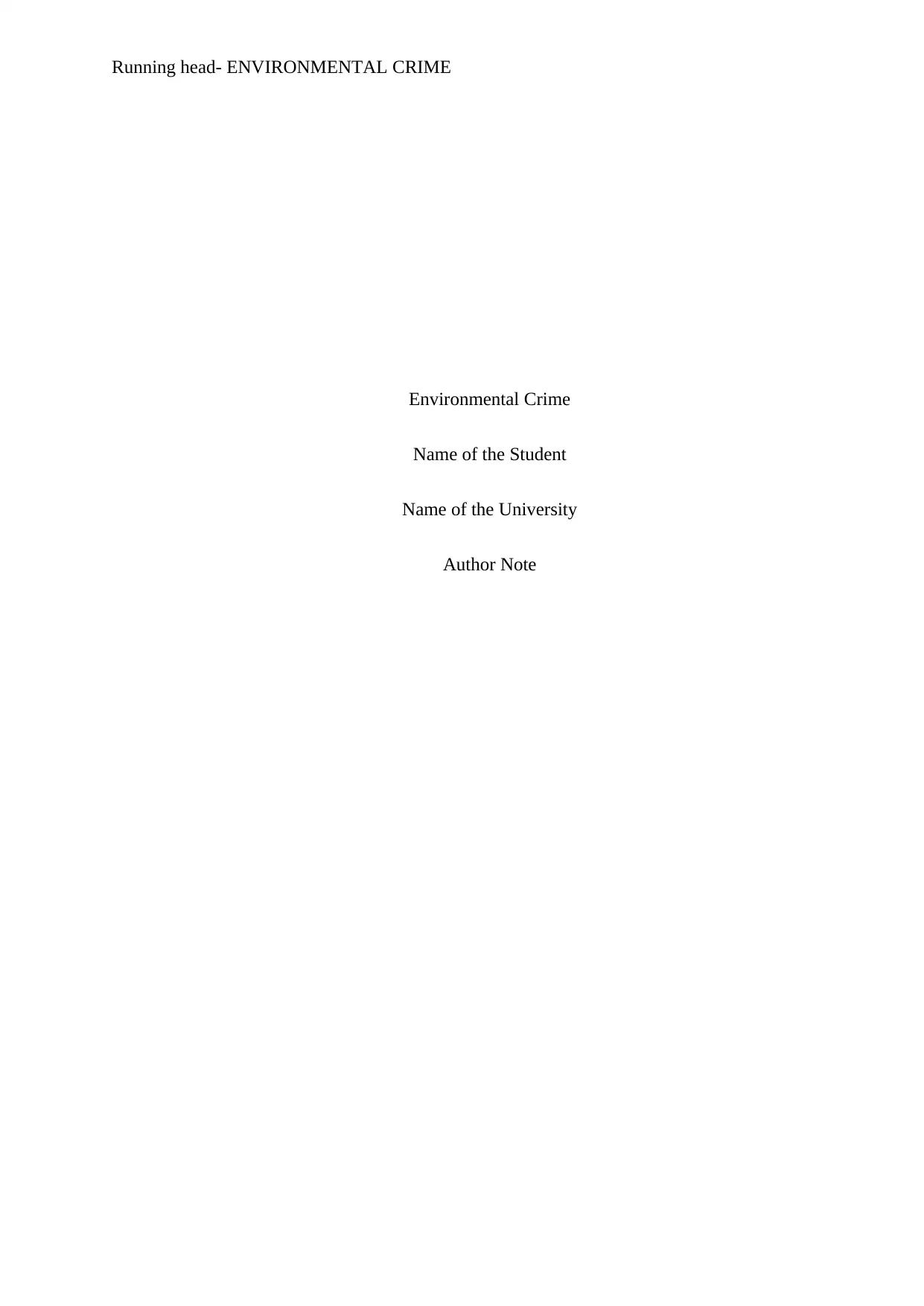
Running head- ENVIRONMENTAL CRIME
Environmental Crime
Name of the Student
Name of the University
Author Note
Environmental Crime
Name of the Student
Name of the University
Author Note
Paraphrase This Document
Need a fresh take? Get an instant paraphrase of this document with our AI Paraphraser
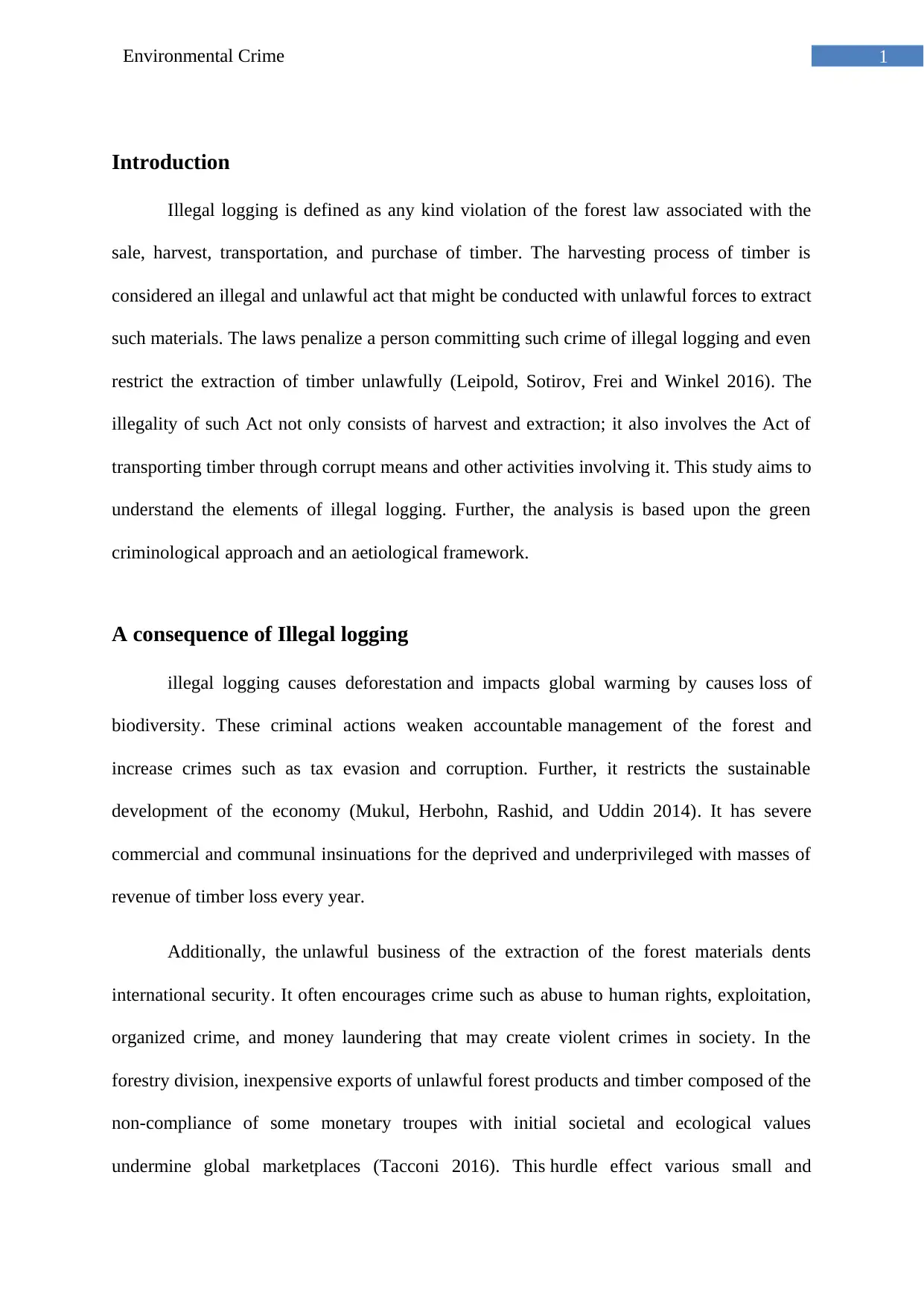
1Environmental Crime
Introduction
Illegal logging is defined as any kind violation of the forest law associated with the
sale, harvest, transportation, and purchase of timber. The harvesting process of timber is
considered an illegal and unlawful act that might be conducted with unlawful forces to extract
such materials. The laws penalize a person committing such crime of illegal logging and even
restrict the extraction of timber unlawfully (Leipold, Sotirov, Frei and Winkel 2016). The
illegality of such Act not only consists of harvest and extraction; it also involves the Act of
transporting timber through corrupt means and other activities involving it. This study aims to
understand the elements of illegal logging. Further, the analysis is based upon the green
criminological approach and an aetiological framework.
A consequence of Illegal logging
illegal logging causes deforestation and impacts global warming by causes loss of
biodiversity. These criminal actions weaken accountable management of the forest and
increase crimes such as tax evasion and corruption. Further, it restricts the sustainable
development of the economy (Mukul, Herbohn, Rashid, and Uddin 2014). It has severe
commercial and communal insinuations for the deprived and underprivileged with masses of
revenue of timber loss every year.
Additionally, the unlawful business of the extraction of the forest materials dents
international security. It often encourages crime such as abuse to human rights, exploitation,
organized crime, and money laundering that may create violent crimes in society. In the
forestry division, inexpensive exports of unlawful forest products and timber composed of the
non-compliance of some monetary troupes with initial societal and ecological values
undermine global marketplaces (Tacconi 2016). This hurdle effect various small and
Introduction
Illegal logging is defined as any kind violation of the forest law associated with the
sale, harvest, transportation, and purchase of timber. The harvesting process of timber is
considered an illegal and unlawful act that might be conducted with unlawful forces to extract
such materials. The laws penalize a person committing such crime of illegal logging and even
restrict the extraction of timber unlawfully (Leipold, Sotirov, Frei and Winkel 2016). The
illegality of such Act not only consists of harvest and extraction; it also involves the Act of
transporting timber through corrupt means and other activities involving it. This study aims to
understand the elements of illegal logging. Further, the analysis is based upon the green
criminological approach and an aetiological framework.
A consequence of Illegal logging
illegal logging causes deforestation and impacts global warming by causes loss of
biodiversity. These criminal actions weaken accountable management of the forest and
increase crimes such as tax evasion and corruption. Further, it restricts the sustainable
development of the economy (Mukul, Herbohn, Rashid, and Uddin 2014). It has severe
commercial and communal insinuations for the deprived and underprivileged with masses of
revenue of timber loss every year.
Additionally, the unlawful business of the extraction of the forest materials dents
international security. It often encourages crime such as abuse to human rights, exploitation,
organized crime, and money laundering that may create violent crimes in society. In the
forestry division, inexpensive exports of unlawful forest products and timber composed of the
non-compliance of some monetary troupes with initial societal and ecological values
undermine global marketplaces (Tacconi 2016). This hurdle effect various small and
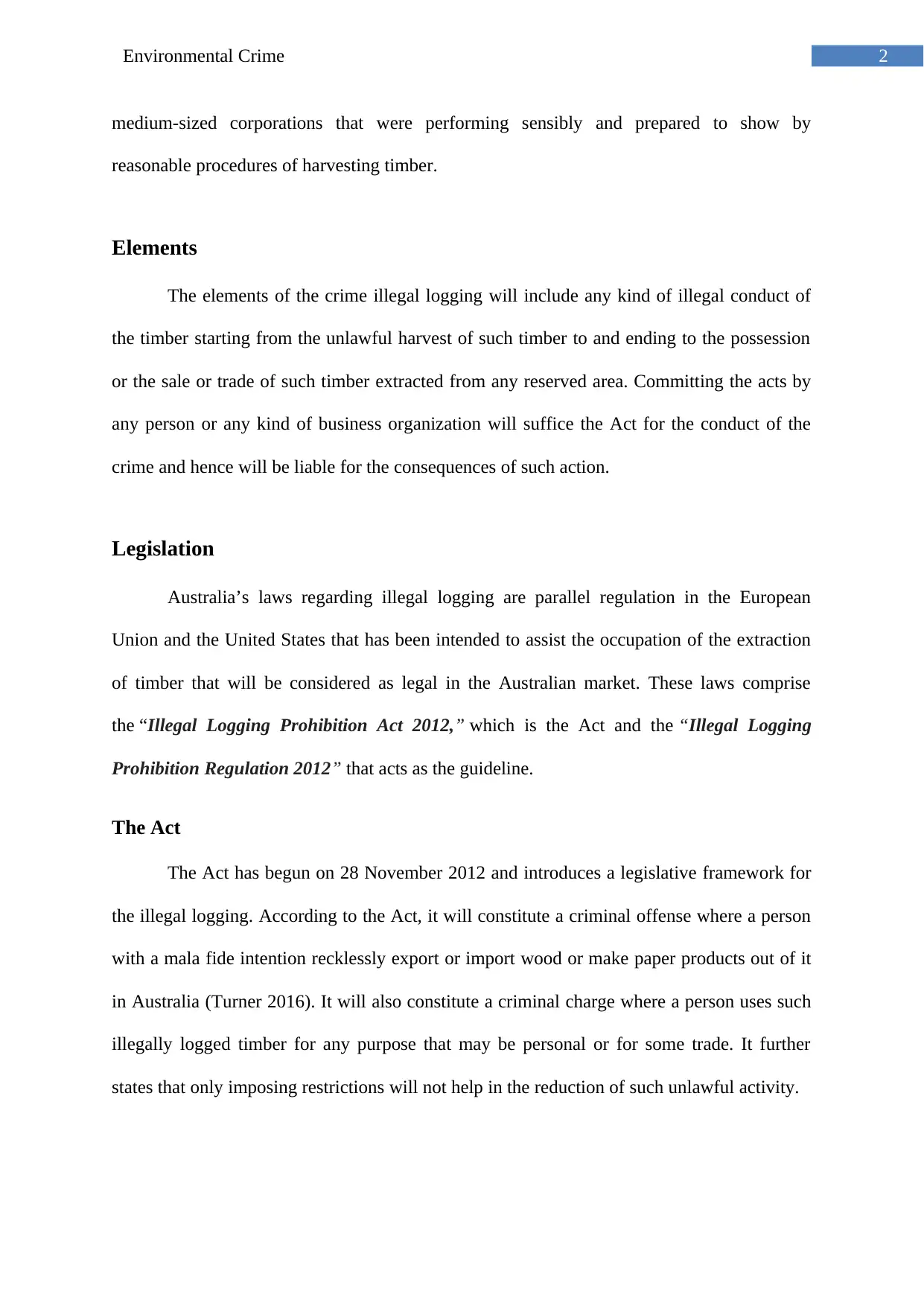
2Environmental Crime
medium-sized corporations that were performing sensibly and prepared to show by
reasonable procedures of harvesting timber.
Elements
The elements of the crime illegal logging will include any kind of illegal conduct of
the timber starting from the unlawful harvest of such timber to and ending to the possession
or the sale or trade of such timber extracted from any reserved area. Committing the acts by
any person or any kind of business organization will suffice the Act for the conduct of the
crime and hence will be liable for the consequences of such action.
Legislation
Australia’s laws regarding illegal logging are parallel regulation in the European
Union and the United States that has been intended to assist the occupation of the extraction
of timber that will be considered as legal in the Australian market. These laws comprise
the “Illegal Logging Prohibition Act 2012,” which is the Act and the “Illegal Logging
Prohibition Regulation 2012” that acts as the guideline.
The Act
The Act has begun on 28 November 2012 and introduces a legislative framework for
the illegal logging. According to the Act, it will constitute a criminal offense where a person
with a mala fide intention recklessly export or import wood or make paper products out of it
in Australia (Turner 2016). It will also constitute a criminal charge where a person uses such
illegally logged timber for any purpose that may be personal or for some trade. It further
states that only imposing restrictions will not help in the reduction of such unlawful activity.
medium-sized corporations that were performing sensibly and prepared to show by
reasonable procedures of harvesting timber.
Elements
The elements of the crime illegal logging will include any kind of illegal conduct of
the timber starting from the unlawful harvest of such timber to and ending to the possession
or the sale or trade of such timber extracted from any reserved area. Committing the acts by
any person or any kind of business organization will suffice the Act for the conduct of the
crime and hence will be liable for the consequences of such action.
Legislation
Australia’s laws regarding illegal logging are parallel regulation in the European
Union and the United States that has been intended to assist the occupation of the extraction
of timber that will be considered as legal in the Australian market. These laws comprise
the “Illegal Logging Prohibition Act 2012,” which is the Act and the “Illegal Logging
Prohibition Regulation 2012” that acts as the guideline.
The Act
The Act has begun on 28 November 2012 and introduces a legislative framework for
the illegal logging. According to the Act, it will constitute a criminal offense where a person
with a mala fide intention recklessly export or import wood or make paper products out of it
in Australia (Turner 2016). It will also constitute a criminal charge where a person uses such
illegally logged timber for any purpose that may be personal or for some trade. It further
states that only imposing restrictions will not help in the reduction of such unlawful activity.
⊘ This is a preview!⊘
Do you want full access?
Subscribe today to unlock all pages.

Trusted by 1+ million students worldwide
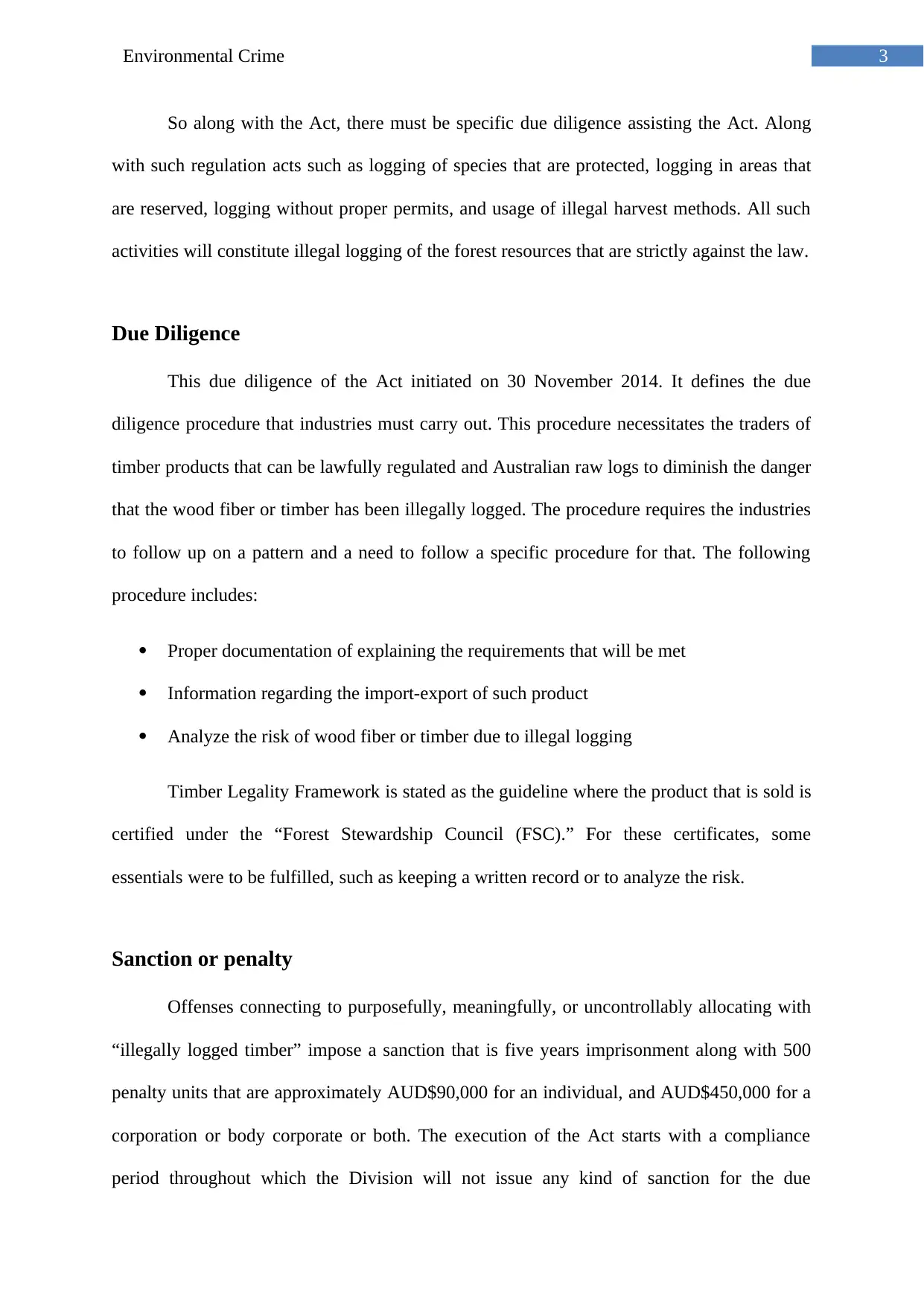
3Environmental Crime
So along with the Act, there must be specific due diligence assisting the Act. Along
with such regulation acts such as logging of species that are protected, logging in areas that
are reserved, logging without proper permits, and usage of illegal harvest methods. All such
activities will constitute illegal logging of the forest resources that are strictly against the law.
Due Diligence
This due diligence of the Act initiated on 30 November 2014. It defines the due
diligence procedure that industries must carry out. This procedure necessitates the traders of
timber products that can be lawfully regulated and Australian raw logs to diminish the danger
that the wood fiber or timber has been illegally logged. The procedure requires the industries
to follow up on a pattern and a need to follow a specific procedure for that. The following
procedure includes:
Proper documentation of explaining the requirements that will be met
Information regarding the import-export of such product
Analyze the risk of wood fiber or timber due to illegal logging
Timber Legality Framework is stated as the guideline where the product that is sold is
certified under the “Forest Stewardship Council (FSC).” For these certificates, some
essentials were to be fulfilled, such as keeping a written record or to analyze the risk.
Sanction or penalty
Offenses connecting to purposefully, meaningfully, or uncontrollably allocating with
“illegally logged timber” impose a sanction that is five years imprisonment along with 500
penalty units that are approximately AUD$90,000 for an individual, and AUD$450,000 for a
corporation or body corporate or both. The execution of the Act starts with a compliance
period throughout which the Division will not issue any kind of sanction for the due
So along with the Act, there must be specific due diligence assisting the Act. Along
with such regulation acts such as logging of species that are protected, logging in areas that
are reserved, logging without proper permits, and usage of illegal harvest methods. All such
activities will constitute illegal logging of the forest resources that are strictly against the law.
Due Diligence
This due diligence of the Act initiated on 30 November 2014. It defines the due
diligence procedure that industries must carry out. This procedure necessitates the traders of
timber products that can be lawfully regulated and Australian raw logs to diminish the danger
that the wood fiber or timber has been illegally logged. The procedure requires the industries
to follow up on a pattern and a need to follow a specific procedure for that. The following
procedure includes:
Proper documentation of explaining the requirements that will be met
Information regarding the import-export of such product
Analyze the risk of wood fiber or timber due to illegal logging
Timber Legality Framework is stated as the guideline where the product that is sold is
certified under the “Forest Stewardship Council (FSC).” For these certificates, some
essentials were to be fulfilled, such as keeping a written record or to analyze the risk.
Sanction or penalty
Offenses connecting to purposefully, meaningfully, or uncontrollably allocating with
“illegally logged timber” impose a sanction that is five years imprisonment along with 500
penalty units that are approximately AUD$90,000 for an individual, and AUD$450,000 for a
corporation or body corporate or both. The execution of the Act starts with a compliance
period throughout which the Division will not issue any kind of sanction for the due
Paraphrase This Document
Need a fresh take? Get an instant paraphrase of this document with our AI Paraphraser
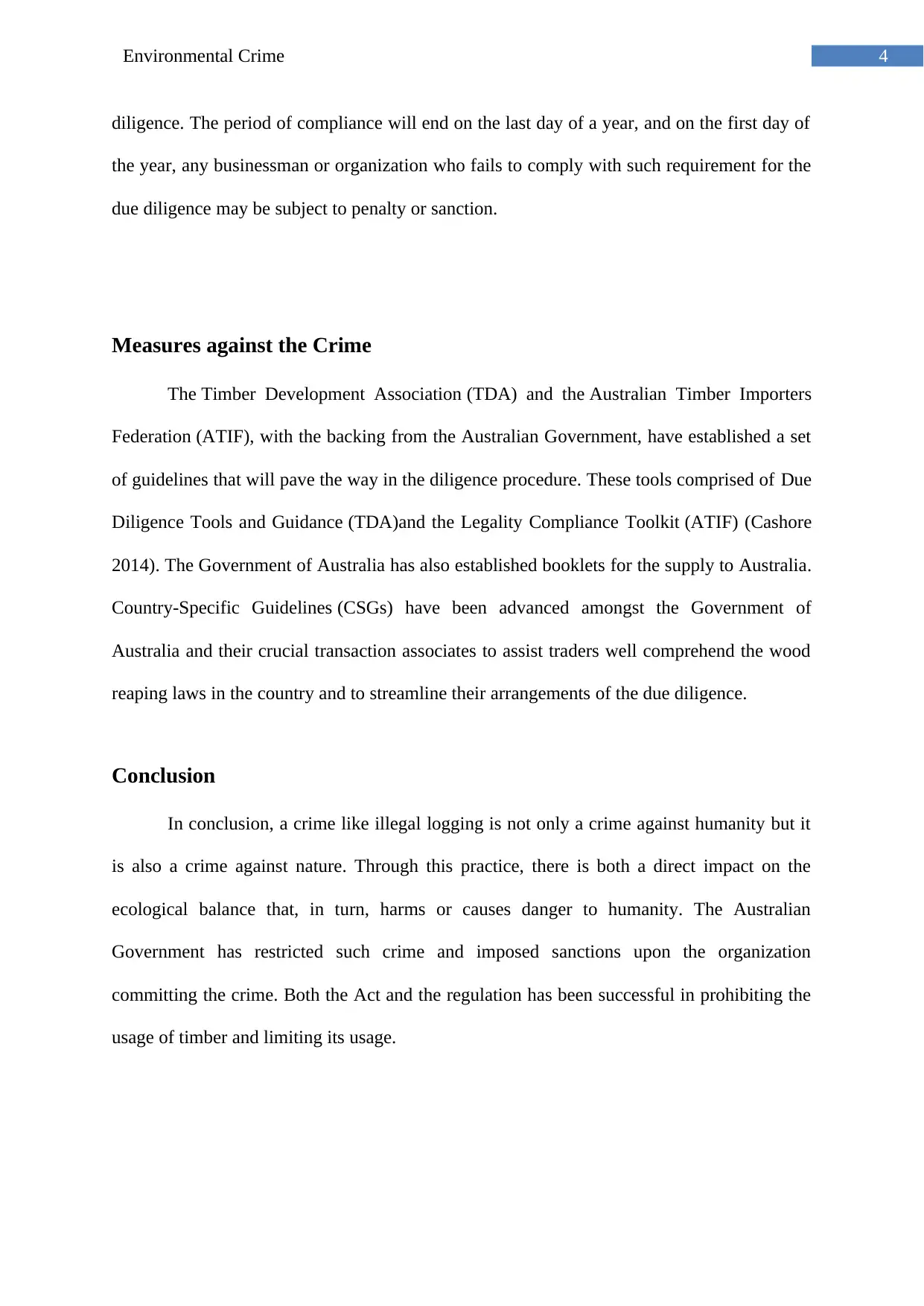
4Environmental Crime
diligence. The period of compliance will end on the last day of a year, and on the first day of
the year, any businessman or organization who fails to comply with such requirement for the
due diligence may be subject to penalty or sanction.
Measures against the Crime
The Timber Development Association (TDA) and the Australian Timber Importers
Federation (ATIF), with the backing from the Australian Government, have established a set
of guidelines that will pave the way in the diligence procedure. These tools comprised of Due
Diligence Tools and Guidance (TDA)and the Legality Compliance Toolkit (ATIF) (Cashore
2014). The Government of Australia has also established booklets for the supply to Australia.
Country-Specific Guidelines (CSGs) have been advanced amongst the Government of
Australia and their crucial transaction associates to assist traders well comprehend the wood
reaping laws in the country and to streamline their arrangements of the due diligence.
Conclusion
In conclusion, a crime like illegal logging is not only a crime against humanity but it
is also a crime against nature. Through this practice, there is both a direct impact on the
ecological balance that, in turn, harms or causes danger to humanity. The Australian
Government has restricted such crime and imposed sanctions upon the organization
committing the crime. Both the Act and the regulation has been successful in prohibiting the
usage of timber and limiting its usage.
diligence. The period of compliance will end on the last day of a year, and on the first day of
the year, any businessman or organization who fails to comply with such requirement for the
due diligence may be subject to penalty or sanction.
Measures against the Crime
The Timber Development Association (TDA) and the Australian Timber Importers
Federation (ATIF), with the backing from the Australian Government, have established a set
of guidelines that will pave the way in the diligence procedure. These tools comprised of Due
Diligence Tools and Guidance (TDA)and the Legality Compliance Toolkit (ATIF) (Cashore
2014). The Government of Australia has also established booklets for the supply to Australia.
Country-Specific Guidelines (CSGs) have been advanced amongst the Government of
Australia and their crucial transaction associates to assist traders well comprehend the wood
reaping laws in the country and to streamline their arrangements of the due diligence.
Conclusion
In conclusion, a crime like illegal logging is not only a crime against humanity but it
is also a crime against nature. Through this practice, there is both a direct impact on the
ecological balance that, in turn, harms or causes danger to humanity. The Australian
Government has restricted such crime and imposed sanctions upon the organization
committing the crime. Both the Act and the regulation has been successful in prohibiting the
usage of timber and limiting its usage.
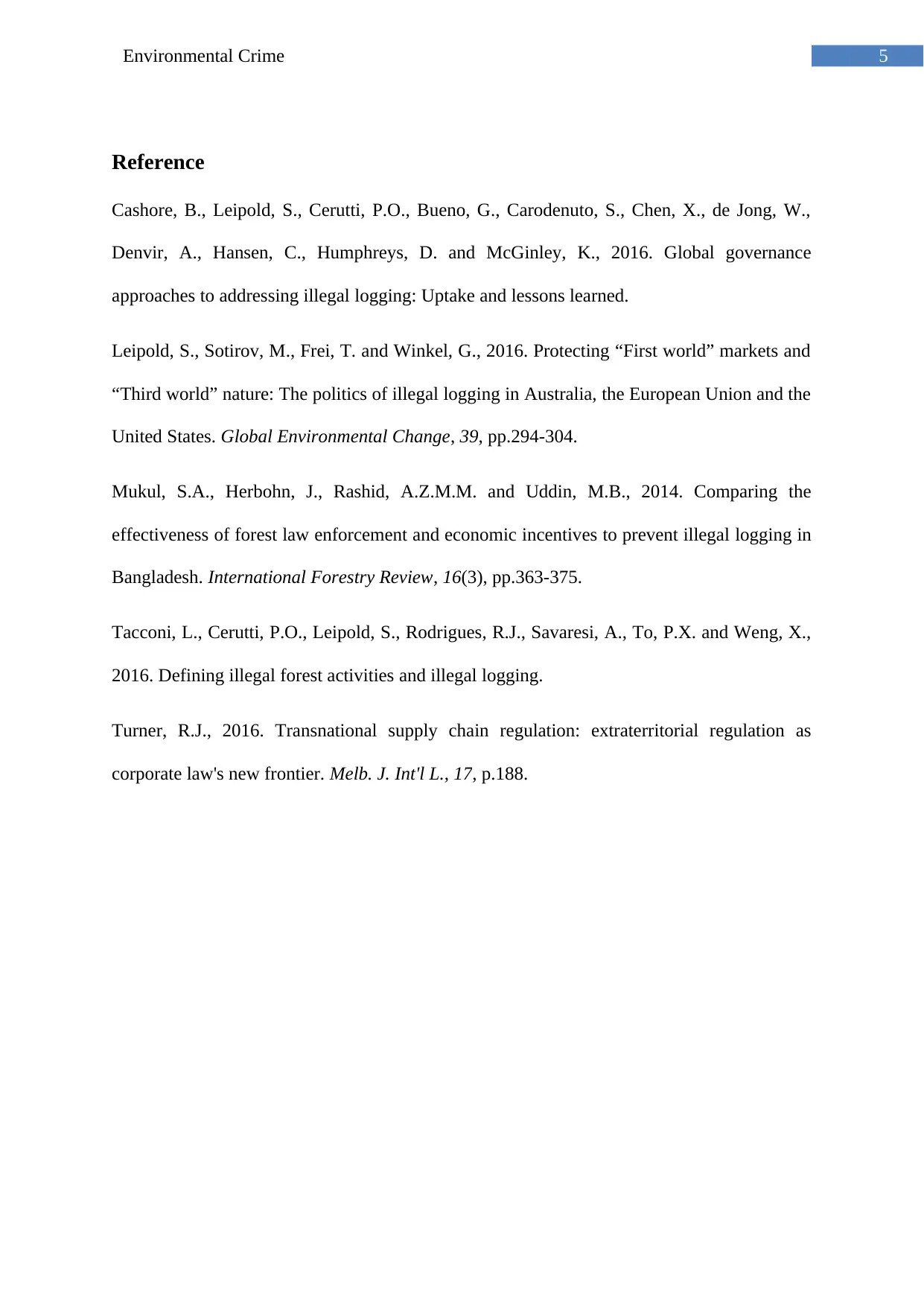
5Environmental Crime
Reference
Cashore, B., Leipold, S., Cerutti, P.O., Bueno, G., Carodenuto, S., Chen, X., de Jong, W.,
Denvir, A., Hansen, C., Humphreys, D. and McGinley, K., 2016. Global governance
approaches to addressing illegal logging: Uptake and lessons learned.
Leipold, S., Sotirov, M., Frei, T. and Winkel, G., 2016. Protecting “First world” markets and
“Third world” nature: The politics of illegal logging in Australia, the European Union and the
United States. Global Environmental Change, 39, pp.294-304.
Mukul, S.A., Herbohn, J., Rashid, A.Z.M.M. and Uddin, M.B., 2014. Comparing the
effectiveness of forest law enforcement and economic incentives to prevent illegal logging in
Bangladesh. International Forestry Review, 16(3), pp.363-375.
Tacconi, L., Cerutti, P.O., Leipold, S., Rodrigues, R.J., Savaresi, A., To, P.X. and Weng, X.,
2016. Defining illegal forest activities and illegal logging.
Turner, R.J., 2016. Transnational supply chain regulation: extraterritorial regulation as
corporate law's new frontier. Melb. J. Int'l L., 17, p.188.
Reference
Cashore, B., Leipold, S., Cerutti, P.O., Bueno, G., Carodenuto, S., Chen, X., de Jong, W.,
Denvir, A., Hansen, C., Humphreys, D. and McGinley, K., 2016. Global governance
approaches to addressing illegal logging: Uptake and lessons learned.
Leipold, S., Sotirov, M., Frei, T. and Winkel, G., 2016. Protecting “First world” markets and
“Third world” nature: The politics of illegal logging in Australia, the European Union and the
United States. Global Environmental Change, 39, pp.294-304.
Mukul, S.A., Herbohn, J., Rashid, A.Z.M.M. and Uddin, M.B., 2014. Comparing the
effectiveness of forest law enforcement and economic incentives to prevent illegal logging in
Bangladesh. International Forestry Review, 16(3), pp.363-375.
Tacconi, L., Cerutti, P.O., Leipold, S., Rodrigues, R.J., Savaresi, A., To, P.X. and Weng, X.,
2016. Defining illegal forest activities and illegal logging.
Turner, R.J., 2016. Transnational supply chain regulation: extraterritorial regulation as
corporate law's new frontier. Melb. J. Int'l L., 17, p.188.
⊘ This is a preview!⊘
Do you want full access?
Subscribe today to unlock all pages.

Trusted by 1+ million students worldwide
1 out of 6
Related Documents
Your All-in-One AI-Powered Toolkit for Academic Success.
+13062052269
info@desklib.com
Available 24*7 on WhatsApp / Email
![[object Object]](/_next/static/media/star-bottom.7253800d.svg)
Unlock your academic potential
Copyright © 2020–2025 A2Z Services. All Rights Reserved. Developed and managed by ZUCOL.





